Photo

Because it was on the market so long, it’s easy to forget how much of an advance the MGB was over the MGA when it was new and how loved it was by customers. The A, on sale for only seven years in the pre-regulations era, is remembered as a pure and jaunty. The B was on sale for 18 years from Camelot to Thatcher, and is often remembered for the compromises that had to be made to keep it going. Still, you can’t sell 500,000 specialty cars if the basic package isn’t good. In 1957, serious work began on replacing the A, with Hayter collaborating with Pietro Frua on EX205, and designing a new coupe, EX214, both based on the existing A structure. Frua’s bits were rejected and 205 deemed too hard to produce. With the recent arrival of the Hillman Minx-based Sunbeam Alpine, both MG chief engineer Syd Enever and boss John Thornley decided a new monocoque would be a better blend of modernity and handling than a reworked A. The body design, both structural and cosmetic, was handled by staffer Don Hayter, an ex-Aston man. In the early days, that very rigid unibody; larger interior and added creature comforts; bigger engine; and Hayter’s pretty styling were all seen as a big leap over the MGA to mainstream customers. Some components, like the MGA’s steering, were carried over. Others, like the leaf-sprung rear, were kept simple for cost. That got the car into production at a friendly price but bit later on when newer cars came on the scene. Sophisticated or not, in 1962 it was a sharp handler with good performance, and sold well from the start. One thing MG itself struggled with was creating a coupe variation as on the MGA. Here BMC’s relationship with Pininfarina (who had also assisted Hayter with the overall B) came in handy. The Italians raised the roof and designed the pretty hatch structure to sit atop a mostly unchanged B shell, almost identical to Hayter’s original below the beltline. The result was one of the prettiest sports coupes of the sixties, and a better fit for tall persons than the roadster even if it’s “back seat” was more a concept than a reality. The GT began rolling off the line in late 1965 and only helped drive MGB sales even higher. https://www.instagram.com/p/CM-fULul3DL/?igshid=rioq7rt0ieit
4 notes
·
View notes
Photo

It does not have a Hemi, because 1951 was just one year before DeSoto added the 276-cube “Fire Dome,” but this ‘51 DeSoto does show off the make’s first foray into the most popular body type of the fifties: Hardtops. There had been hardtops as far back as the wood-framed body days of the WW1 era, but the modern concept of the hardtop was still the province of exotic, custom-bodied luxury cars before WW2. Think Delages or V16 Cadillacs. After 1950-51, however, they were democratized for the first time, and people love them. In 1949, when Buick and Kaiser-Frazer started selling the very first affordable hardtops, the idea was so popular that most major manufacturers added them by 1952. Chrysler might have gotten in earlier. In 1946, the company experimented with a few prototype production hardtops, welding club coupe tops onto a handful of Town & Country convertibles. This seemed impractical and the cars were drafty, as most hardtops would be compared to cars with fixed pillars later on, so the idea was postponed. Buick showed off the first Roadmaster Riviera in January of 1949, and Kaiser it’s four-door Virginian a month later. The Kaiser never quite resonated, but the Riviera was a hit, and quickly followed by glamorous, closely-related hardtop coupes from Cadillac and Olds. The response was so enthusiastic that Chevy and Pontiac got hardtops for 1950. Not wanting to be left out, Chrysler also developed hardtops for 1950, the first being, well, a wood-framed Town & Country convertible with a hardtop welded on, now called the Town & Country Newport for the toney Rhode Island city. Then it created steel-bodied versions, including one for DeSoto appearing mid-1950. DeSoto was also in its way a pioneer of hardtops, having built a prototype pillarless sedan in 1933, only to have it nixed in favor of the 1934 Airflow, a disastrous decision for DeSoto, which often struggled to find an identity within Chrysler after the company acquired Dodge very soon after DeSoto was first launched. The ‘51 was not that exciting, powered as it was by a 250-cid flathead six, but it was reliable and stately, and DeSotos were never more popular than in the first half of the fifties. (at Ballard, Seattle) https://www.instagram.com/p/CM7r00XFilX/?igshid=iah55eozuit8
2 notes
·
View notes
Photo

Happy #Frontendfriday! Revisiting one that got away today, I drove this Euro-spec 1980 Mercedes 280SE back in 2008, but ended up buying a 1983 BMW E21 instead. The E21 was a great car, but I always regretted passing on the #W116. This grey-market car was somebody’s private import in the 1980s, when many Mercedes and BMW enthusiasts wanted the slightly more powerful (and cleaner looking) Euro-spec cars, which could still be imported fairly easily at the time and were sometimes cheaper than buying a U.S.-spec car. Then as now, the S-Klasse did not come cheap. The 280SE, the volume leader in Europe but not always the most popular in the USA, was a $26,000 car in 1980, so you can see how big spenders might want to have things their way. It’s sometimes overshadowed by its W126 successor, but the Mercedes W116 S-class was a car of many firsts and one last, it arguably set the stage for the W126, which evolved out of the older car. The “last” was that it was the final car designed under Friedrich Geiger, who retired after 40 years with M-B in 1973 - though he hardly labored alone. Work on the W116 began in late 1965 and Paul Bracq, Bruno Sacco, Peter Pfeiffer, Joseph Gallitzendörfer and Gérard Cardiet all contributed to it. The W116 was the first to officially wear the S-Klasse distinction, the first turbodiesel Merc (strangely the U.S.-only 300SD), and the first car with modern anti-lock brakes. In traditional Mercedes fashion, it was very safe and built like a bank vault. Early W116 prototypes were a part of Mercedes ESF safety vehicle program. It debuted at the 1972 Paris show, and arrived in the U.S. in 1973 as a V8 only. The M110-six powered 280S belatedly arrived in 1975, possibly as a response to OPEC 1. Many U.S. customers knew by 1975 that Mercedes meant real quality and engineering, but the rather bare-bones 280S was twice the price of a Cadillac and found few takers. The addition of Fuel injection and more equipment on the 280S in 1977 helped but the heavy car still only made 142hp (down from 177 in Europe). The simpler M110 engine and lighter weight made the 280SE a durable workhorse, but who wouldn’t want extra power and a green cloth interior? (at Oradell, New Jersey) https://www.instagram.com/p/CM40RwWlBx-/?igshid=yiklg3ox5d2h
1 note
·
View note
Photo
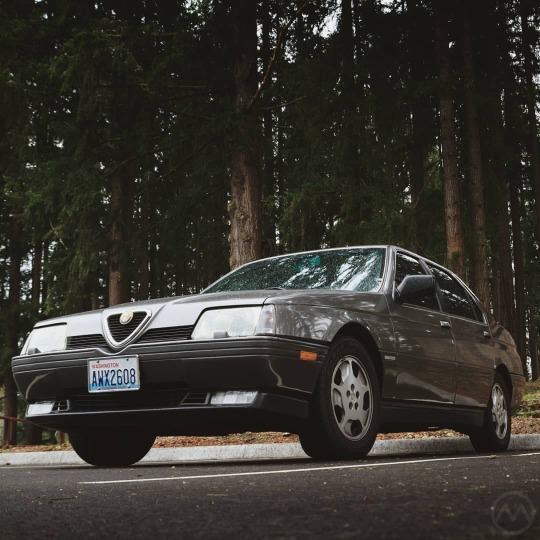
Alfa-Romeo’s 164 arrived in Europe in late 1987, but Americans had to wait - the car didn’t come over to the U.S. until early 1990. At the time, it was the first truly new U.S. Alfa since 1975, as all of the stateside Alfas since that time had either been Spiders or Alfetta based. The 164 was highly anticipated by both enthusiasts and dealers, and promised to be Alfa’s most modern product to date. It was also the second sedan in five years that Alfa pinned its U.S hopes on. The outgoing Milano (aka 75) had done well at first, but slumped to under 1,000 units in 1989 in the face of spotty quality and shifting exchange rates. Needless to say, things didn’t work out as planned, but the 164 was a rewarding car. The 164 was the last car developed by Alfa before Fiat's takeover, but like the other "Type Four" cars (Saab 9000, Fiat Croma, Lancia Thema), it had been in development a long time, at first as a solo Alfa project and then as one of the Type 4s after 1982 thanks to state-owned Alfa's thin resources. The other type fours began their gestation around the same time in 1978, and all four had their own flavors that accurately reflected their brands, though the 9000 and the Croma were cosmetically similar. Being the last to join the groups and the last to market, the 164 was probably the most well-differentiated of the set. It didn't hurt that it wore a sharp Pininfarina suit by Enrico Fumia and that the 183-hp 3.0 "Busso" V6 was at the heart of the car, at least in the U.S. European versions had a 2L V6, a pair of 2L gas & 2.5L turbodiesel fours, but the U.S. range was restricted to the 3L V6. The 1991 recession, arriving just as cars hit dealers, and lingering fears about Alfa reliability meant the 164 struggled, but those who bought were rewarded with a handsome and fun car, either in regular form or with a body-kitted “S” model. You still needed money to run one, but aside from complex electronics they proved surprisingly durable, and there are plenty still around. 1994 brought styling revisions and 210 hp, but with the old Spider gone, Alfa sales sank to just a few hundred units, and Alfa said arrivederci to the USA in the fall of 1995. https://www.instagram.com/p/CM2NsbHl0g9/?igshid=x2t2yp313vxk
1 note
·
View note
Photo
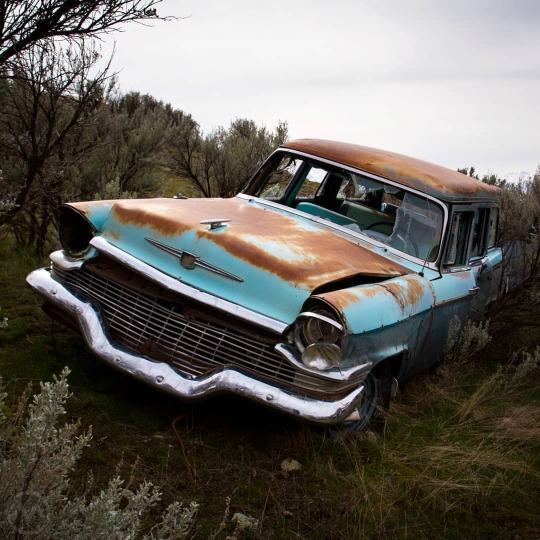
Because Packard’s decline was long and public, and because the prestige brand exited the stage almost a decade before Studebaker, many people assume Packard was the weaker of the two companies when they merged. That wasn’t necessarily so. In 1953 Packard was still relatively healthy and debt free until a series of unfortunate twists of fate, culminating in the loss of Packard’s main body supplier, Briggs, to an acquisition by Chrysler. From there on, a merger was the only way to keep the company alive, and Packard’s James Nance negotiated with both Nash and Studebaker. Hudson was not considered worth the trouble by Packard’s board). The board also refused to hear Nash boss George Mason’s proposals for merging into the nascent AMC (Nash & Hudson) in 1954, and instead chose to listen to rosy predictions from Lehman Brothers, who arranged the merger between S and P. The board, if not Nance, were so taken with Studebaker that they never even ordered an independent review of its books, and ended saddled with a debt-ridden mess. New Packards with new V8s debuted for 1955, but production delays and quality ills took the rose off the bloom quickly, and while not a bad year, sales were way below expectations. In the next 14 months Nance did everything he could think of to get a new Packard to market, including approaching Ford about buying the tooling for the ’56 Lincoln (unsurprisingly, Ford said no). Production of the big new Packards ended on June 15, 1956. But that wasn’t the end. To make Packard franchises happy, a new Packard built in South Bend debuted in January, 1957. Packard’s ’55 V8 engine had cost $20M to develop. The entire car that became known as the #Packardbaker, a lightly restyled Studebaker President, was designed for $1.1M, and it showed. Poorly received, just 4,809 were sold (down 70% from ’56), including only 869 “country sedans,” Packard’s word for #wagon. The Packardbaker wasn’t actually a bad car to look at or drive, future star designers Bill Schmidt (later of Chrysler), Dick Teague (AMC), and chief modeler Fritz Wagner did everything they could for it. But it was way too little, way too late. Packard production ceased on June 13, 1958. https://www.instagram.com/p/CMzsonbl6VR/?igshid=2npbkuxx7z7e
0 notes
Photo

After the summer of 1985, if you wanted a full-size, rear-drive, two-door GM car your only option was the Caprice, and the biggest two-door Detroiters were a distinctly endangered species at the time. By 1988, they were extinct. While big cars recovered from the fallout of OPEC 2 in the mid-1980s, big coupes were largely left behind. Oldsmobile and Buick did pretty well with their Delta 88 and LeSabre coupes in the early 1980s, but the biggest coupes faced the triple-whammy of successive fuel crises, changing tastes, and being seen as “old people’s cars.” Chrysler’s full-size two-doors did not survive the 1970s, and Lincoln’s were cancelled after 1983. When Buick, Olds, and Cadillac went fwd in 1985, it left only Chevy, Ford, and Mercury offering the type. When GM’s downsized B-body cars were new in the fall of 1976, they were radical and different. But seven years later they were viewed as old and traditional, despite the fact that many of their elephantine predecessors were still on the road. In the first three years, the coupes sold well, and they sported a unique roofline with a pretty panoramic backlight. In 1980, the B’s got a more formal, but also more aerodynamic look. But after the restyle, OPEC 2, and the sharp 1980-81 recession, Impala coupes were hard to move and dropped altogether in late 1981. Chevy dropped the Caprice Coupe for ‘83 after having moved less than 12K ‘82s, down from 72K sold in 1977. But dealers still wanted them, so the Caprice coupe returned for 1984. Pent up demand saw Caprice Coupe sales rise to 19K cars but, you’ll note, that’s not much demand. They fell to 11K 1985 and 9K for 1986. While the other B-body coupes were cancelled, the Caprice got a refresh in ‘85 and added a new base engine, Chevy’s long-serving 4.3L V6, primarily used in trucks. The Caprice Coupe was by this time a specialty item, and this one has the Landau package, which added a vinyl top and extra chrome trim, so it’s a curious combo of base engine and what seems like a full complement of options. Good looking but largely unwanted, the Caprice Coupe limped in 1987 with yet another visual freshening, but was cancelled forever that year after just 3K sales. https://www.instagram.com/p/CMxU0H3FmMu/?igshid=zvj38hg4e4if
0 notes
Photo
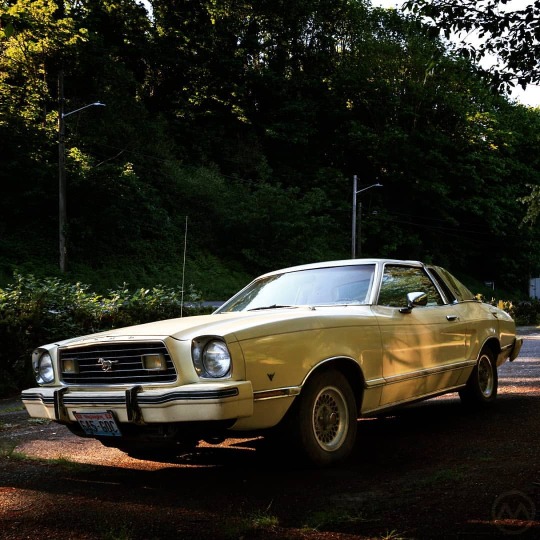
The general consensus among the automotive press, and car buyers, was that the 1971 Mustang was too big and too heavy. It’s true that the vast hood and low seats made it feel rather like an Eldorado from the inside, but it wasn’t as big and heavy as it’s often made out to be, it just looked that way. Still, in the early 1970s Pony cars were suddenly a harder sell and Ford, informed by foreign coupes like the Capri and Toyota Celica, set out to create something smaller and more tailored to the times. That’s how the Mustang II, “the little jewel” as Lee Iacocca called it, came to be. It seemed anathema to Mustang fans, but it was the right car for its time. When the 1974 Mustang was in the planning phase in 1970, muscle cars were just beginning to fade, and even bigger designs than the ‘71 car were cast off in favor of a reinvention of the original formula. Iacocca himself said that the Capri, imported and sold by Mercury but inspired by the Mustang, was a better Mustang than the ‘71. Iacocca wasn’t alone in that thinking and even the general public, at the 1971 shareholders meeting, commented on it. Sales of the Celica, Capri, and Opel Manta doubled from 1970 to 1972 and looked poised to double again by 1974 while Muscle cars were in free-fall, so the entire program was reworked to get in on the action. To create the ‘74, Iacocca had the development teams turn to the Pinto platform and designed the new car around that. But switching horses took time, and as such, the Mustang II turned into a bit of a rush job. It emerged a foot and a half shorter than the ‘73, but only 300lbs. lighter, and the front subframe later beloved of hot-rodders was a last-ditch attempt to make it ride smoother. The Mustang II used a mixture of old ‘Stang cues and style boss Gene Bordinat’s favorite neoclassic touches, particularly on the Ghia coupes. Outwardly it seemed the opposite of a regular Mustang, but it was to the Pinto as the original was to the Falcon. The II was well targeted, however, and turned into a home run when OPEC 1 happened just weeks after it went on sale. Almost 386,000 Mustang II’s were sold that first year, but the car aged quickly after 1976. https://www.instagram.com/p/CMu0q4FlJIt/?igshid=1hpmr5ipv55tp
1 note
·
View note
Photo
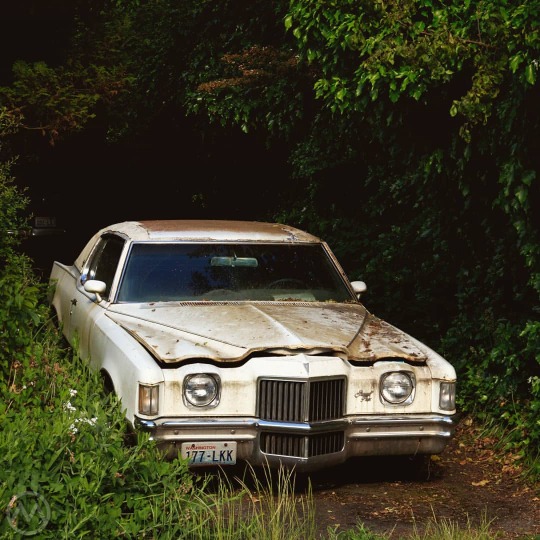
Pop culture remembers the Pontiac GTO and his eponymous DMC-12 as John DeLorean’s most famous cars. The best idea ever advanced, however, in terms of making profits, might have been the 1969-72 Pontiac Grand Prix. According to former GM designer Wayne Vieira, Pontiac’s studios designed a big B-body Grand Prix for 1969, in the mold of the 1962-68 versions, but nobody was happy with it. The big GP wasn’t a strong seller, either, and DeLorean’s acolytes, Bill Collins, Jim Wangers, and Ben Harrison openly debated canceling the GP altogether. Looking over the proposed car, DeLorean told Viera and studio boss Jack Humber, “Why don’t you design this on the A-car platform instead?” Two weeks later, a rough proposal was ready and history was made, but not before a good deal of hectoring between DeLorean and upper management. The proposal had first come from product planner Harrison, and the whole thing was cobbled together quickly once DeLorean, still Pontiac General Manager in 1967, seized on the idea. Instead of another gilded big car, the kind that were fading from fashion, the GP would be a midsize A-car with a big stretch in front and neoclassic styling in the mold of the Cadillac Eldorado, but at a much friendlier price. But Pontiac had no budget for the tooling, and getting it built required getting DeLorean’s former boss Pete Estes, now leading Chevy, to sign on and give Chevy a version for 1970, it also required some battles with upper management and even other division chiefs, as this would be new turf for Pontiac. The decision yielded not only the wildly successful 1969 Pontiac Grand Prix but also the 1970 Chevy Monte Carlo and Olds Cutlass Supreme, which all shared the front stretch and would all be some of GM’s best-selling and most profitable lines in the 1970s. Vieira’s muscular neoclassic shape used Duesenberg-inspired trim designations (J, SJ, and rarely SSJ) at DeLorean’s suggestion, and its prominent grilles were designed by Gordon Brown, who later led the Opel studio. The car was refreshed for 1971 (seen here) with frillier details, twin headlamps, and a “boat tail” rear, a look the GP would keep through its most successful years, 1971-77. https://www.instagram.com/p/CMpkOzoF3Yp/?igshid=1lexcqn5hg72w
2 notes
·
View notes
Photo

American automakers lost $191M in 1932, the equivalent of almost $3 Billion today, and the low price makes, 40% of production in 1928-29, became 80% by ‘32, annihilating the niche luxury makes and taking a heavy toll on mid-price cars like Buick. The tri-shield fell from third place in the industry to eighth as bread lines and Hoovervilles didn’t inspire consumer confidence. Of course, the cars themselves were never better. They were more functional, more reliable, and better looking than ever, as exemplified by this 1933 50-series sedan. Part of Buick’s problem was that it had farther to fall than other makes and things came unglued even before the 1929 stock crash. Buicks were enormously popular in the aspirational, car-happy roaring 20s, but, in perhaps a moment of hubris, 1929 was a big own-goal. The engineering and production department altered the proportions Harley Earl, then still very new at GM, had set out, and the fat-looking ‘29 earned the sobriquet “the Pregnant Buick.” The companion make Marquette, proved a costly fiasco, and so even before the depression things had gone awry. The years from 1931-33 were, therefore, ones of retrenchment, with engineering led by Ferdinand “Dutch” Bower, who was tasked with coming up with a new straight 8 for Buick and making the cars more desirable. Leading the engine design was a young Italian immigrant, John Dolza, who had fled fascism and created what became Buick’s long-running Eight. For 1931, Buicks got much stronger frames and other components for better handling. They got Synchromesh, too, but retained much of 1930’s styling. In 1932 and again in 1933, when valenced fenders inspired by the Graham Blue Streak were added, Earl turned up the wick on the visuals, and the cars were as stately and stylish as the ‘29 had been dowdy. But Buick sales continued to slide in ‘33, and management was shuffled after longtime boss Ed Strong retired in 1932 and Buick was organizationally lumped together with Olds and Pontiac. 1933 sales were less than 1/5th their 1926 total. At the end of the model year a new manager, Harlow Curtice, took charge and immediately set about reinventing Buick’s marketing and sales efforts. https://www.instagram.com/p/CMkbA1Oly52/?igshid=pvay4m6f9xyb
0 notes
Photo
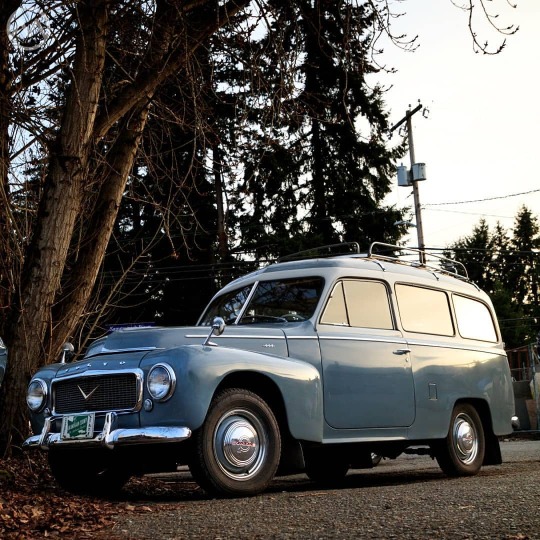
At first glance the #VolvoDuett looks like a simple wagon version of the Swedish firm’s PV444 and 544, but under the skin it’s a very different story. The 444 was a radically advanced car when it was created during WW2 in part because it was a light and strong unibody. The Duett shares the 444’s styling, front clip, and front suspension but in an unusual twist, it’s a conventional body-on-frame machine. The circa-1944 PV444, heavily influenced by the prewar German Hanomag 1.3 Aerodynamic and the 1941-42 Fords, was a highly advanced car for the era. But in designing the regular PV444 as a unibody, Volvo had eliminated the possibility of building a larger version for heavier duty use and a bare chassis for coachbuilders. After hostilities were over the company quickly cooked up a conventional frame version meant for commercial duty and special bodies (mostly very pretty convertibles but also wagons, pickups, and vans), the PV445. By the early 1950s, family wagon conversions of the PV445 from Swedish coachbuilders like Gripkarosser were becoming quite popular, so Volvo decided to get in on the action and designed its own in-house proper station wagon on the 445 chassis. This became 1953’s Duett, an all-steel wagon in the popular mold of the day, with a high roof and lots of utility. It was the first in a loooong line of handy Volvo wagons. The name was inspired by the concept that it could be a “Duet” of family and work use, which is one reason why it was designed with simple external hinges and a little more utilitarian feel than some other wagons. It looks almost SUV-like by today’s standards and you could get it with a truck-like 7P configuration and the roof rack seen here. U.S. Volvo sales began officially in 1956, though a few cars had trickled in earlier. By then the 444/445 styling was a decade out of date, but the hard-wearing and utilitarian virtues of the 445 Duett were just as well-liked as the excellent handling and reliability of the 444. Both earned an enviable rep for quality. This is a fairly early U.S. import from 1957. The 444 gave way to the 544 in 1958, and the Duett got an update too, and it remained in production until 1969. https://www.instagram.com/p/CMiF6belNN2/?igshid=1dwxggig39hzu
2 notes
·
View notes
Photo
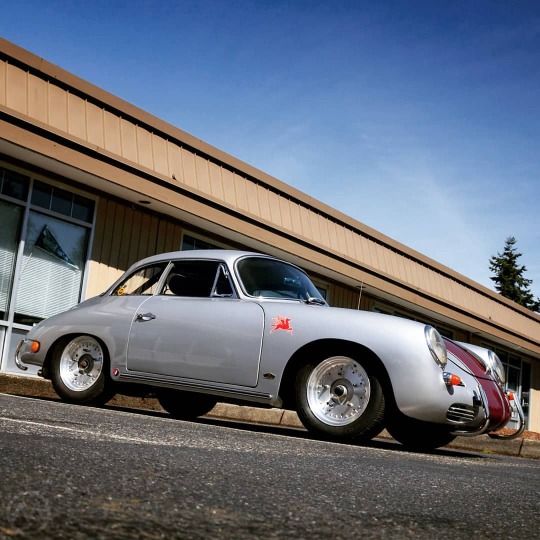
A real rarity today with this Porsche 356B “notchback.” Made in small numbers for just two years, the ‘Notch was an attempt by Porsche to broaden its lineup in a convenient and low-cost way, but it didn’t really work out too well. Karmann supposedly constructed 2,290 of the notchbacks over about 20 months, in two separate series, and despite its rarity, the notch never really developed anywhere near the following of other low-volume 356s like the Speedster. It was a pretty car in its way, but often considered the “ugly duckling” of the 356 line by Porsche-o-philes, who preferred the original 356 Coupe look or, if they could get one, the open versions. The origins of the Notch were fairly simple. Porsche 356 bodies were built primarily by coachbuilder Reutter, an old coachbuilder, starting in 1950. Reutter, founded in 1906, was just down the street from Porsche in Stuttgart-Zuffenhausen, so it was a convenient arrangement for both parties, and Reutter eventually became part of Porsche in 1963, morphing into the business we now know as Recaro (it had developed and built vehicle seating since the 1930s). In the early 1960s, however, Porsche farmed out some 356 bodywork to Karmann in Osnabrück to boost production and would split 356C production between the two. The first project Karmann handled was a second 356 coupe version. The notchback would, theoretically, provide more variety at a time when the original shape of the 356 coupe was getting a little long in the tooth. Karmann received unfinished “T5” 356 convertible bodies from Reutter and welded a hardtop to the car, creating the original 356 notchback coupe of 1961. But the 356 got a significant update for 1962 with the new T6 shell, and while the first 1,000 or so Notches started their lives as convertibles, the second set of cars produced were hardtops based on the new T6 shell from the start. Visually, however, it’d be hard to tell the difference except up close. The Notch was mechanically identical to the regular 356s coupes, but room a little reduced. The Notch didn’t sell, so it did not last beyond the end of 1962, by which time Porsche was looking ahead to launching the Typ 901, which became the 911. (at Triple XXX Burgers) https://www.instagram.com/p/CMfkgqRFAPQ/?igshid=88k8tf8q9riu
0 notes
Photo

Ford was in deep trouble when the #FoxBodyMustang was new, and performance cars were at low ebb, but the car not only thrived, it survived a planned early eighties cancellation and went on to become the king of cheap new muscle machines. At the end of the 1980s the 5.0 Mustang was the choice of a new generation of hot rodders and the car most suburban high schoolers wanted. While the body-kitted GT was often considered the most desirable Fox Mustang short of 1993’s SVT Cobra and Cobra R, the more basic looking LX was the Q-car of the set, looking all the world like a four-cylinder Mustang apart from the subtle “5.0” badge just aft of the front wheel. Prototypes for the 1979 Mustang ran the gamut from ultra-sleek fastbacks to very upright, formal-look cars. The look that won the day was done under Jack Telnack (from a sketch by Fritz Mayhew), recently returned to Detroit from a stint at Ford of Europe. Both a notchback and a hatchback/fastback were developed to customer clinic feedback, though the hatch required personal lobbying of Ford’s financiers and Henry Ford II on Telnack’s part. HFII was not a fan of swept-back front ends. The look was a winner, with more than 370,000 Mustangs moving out the door that first year. Telnack also later said that the car’s slippery looks (it actually had a poor .46 cd) opened the door for his later “Aero” T-bird and Tempo. Four years later, the Mustang got its convertible back after a decade-long absence. In 1979-80, performance was at its lowest ebb, and at that time the future of the fast Fox lay with what became 1984’s SVO Mustang Turbo, but the ‘Stang was slated to be redesigned onto a Mazda platform for 1983-84, a thing which Ford engineers protested, ultimately saving the Mustang (the Mazda idea became the 1988 Ford Probe). The SVO’s sleeker aerodynamics were adapted for the Mustang’s 1987 freshening, while the 302 V8, once an economy engine, morphed into the increasingly powerful fuel-injected 5.0. The Mustang’s relatively light weight, tough hardware, and the 302’s 225hp were a heady combo in new-car showrooms in 1989, and one of the fastest cheap cars you could buy new at the time, and a very popular steed. https://www.instagram.com/p/CMdLehblxTA/?igshid=wqh9zslnrqsy
1 note
·
View note
Photo

A gaggle of rare French machines from the OldMotors archive today; once again from Martinique. A trio of Peugeot 403 pickups are fronted by a Renault Goélette minibus, set to take people from Fort-de-France to the inner community of Gros Morne and on to the east side of the Island and La Trinité. All of these vehicles are designed for work, and all are rare today, though the Peugeot might be easier to spot than the minibus. The Voltigeur (1000kg)/Goélette (1400kg) debuted in 1945 as Renault’s new Type 206 1000kg van, and only got names in 1959, but it was a popular commercial vehicle in France and in francophone countries and overseas territories. Even before WW2 Renault had wanted to build forward control trucks. Car based trucks, Renault figured, devoted too much of the vehicle’s footprint to the engine and not enough to the load area. Citroën and Chenard-Walcker had similar ideas, with Citroën getting there first with 1939’s TUB van. Under occupation, Renault built a long string of forward-control military trucks that had actually been in the design phase since 1937, and the Type 206 was an extension of those, just scaled down under the direction of engineer Fernand Picard. It was ready by the end of 1945 and fit well within the “Plan Pons,” a plan for rationalizing the French car and truck industries by technocrat Paul-Marie Pons and minister of industry Robert LaCoste. Renault and C-W were to build vans between 1000-1400KG, and Citroën would focus on trucks, and the 1000KG fit right in. Citroën ignored the plan and evolved the TUB/TUC vans into the H-van, which later sent Renault back to the drawing board. But in the meantime, the 1000KG was hugely successful. The 1000KG was tough, simple, and space efficient. It was a big metal box on a conventional frame with rear-wheel drive; and it came in a wide array of varieties including jacked up 4WD machines for desert use. One of the rarest, however, is the 1000KG Marchande or “Merchant” van, which had roll-up sides for farmers and merchants to sell wares out of in cities and villages. It could also be used, in warm climes, as plein aire bus. Voltigeur/Goélette production continued into the mid-1960s. (at Fort-de-France) https://www.instagram.com/p/CMXyX-ll1qA/?igshid=1kfa2iz0lmkkr
1 note
·
View note
Photo
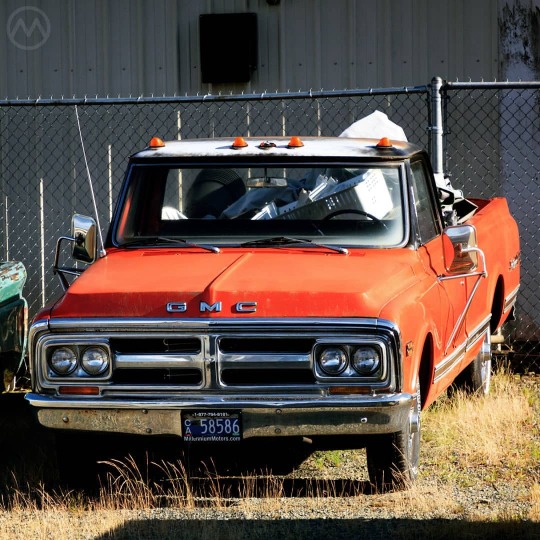
The '67-'72 “Action Line” Chevy & GMC trucks aren't quite as omnipresent as their 1970s Ford counterparts, but that's mainly because the 5th gen F-series (also offered from 1967 to 1972) looks almost identical to the 6th gen, offered from 1973-1979, so it can appear at a glance like there are many more Fords than GM products in these years. In reality, Chevy and GMC sold almost as many as Ford or more, and the trucks are common even now almost everywhere in North America. The GMC versions were essentially identical to the Chevy back then, though today’s Sierra is a bit more differentiated from its Silverado sister. The trucks didn’t get those names until 1999, but both evolved from trim packages on what were then referred to as the “C” and “K” pickups, C’s being rear-drivers and K’s being four-wheel drive units. The Sierra appeared first on this generation, the Silverado on the later “square body” trucks. These are popular sport trucks and restomod trucks today, unsurprisingly given that the cavernous engine bay of the Action Lines was designed to hold big blocks, but they were workhorses when new. The base models used the humble Chevy 250-cube six,but above that were nine different V8s suitable for every possible purpose. The first #bigblock, the Chevy 396, was added in 1968, and in time the 402 was added as well. The Sierra and Sierra Grande packages first appeared in 1969-70, and they were fancier trims on what was not a particularly fancy truck. Certainly, even these “luxury” models for that era seem very humble today. But the added plushness of their interiors made them more popular with people who used their trucks every day (still not that many people in the early 1970s) and in 1972 they became full trim lines of their own. This particular GMC K1500 Grand Sierra was built for hauling or towing, as evidenced by the wide mirrors, and is probably one of the earliest Sierras around. By 1972 a significant minority of these trucks were being optioned up for style and luxury at the time, marking a distinct shift in how pickups were marketed. The Sierra continued to be a staple of GMC marketing until becoming its own model name at the end of the century. (at Monroe, Washington) https://www.instagram.com/p/CMVQV1hlNmu/?igshid=ymbq6komnew4
1 note
·
View note
Photo

It’s a little ironic that the 1979 Lincoln Continental is remembered as the last of the “truly traditional” land yachts. Frilly, opera-windowed, and larger than life, the popularity of the late 1970s big Lincolns ensured they would forever be remembered as the Disco era’s most gilded lilies, but that’s not how the car was originally envisaged. The 1979 Continentals were mechanically not much different from the car introduced in 1970, but the original vision was one of slab-sided, mid-century modern sparseness, not Parthenon grills. The 1970 Lincoln was meant to follow in the footsteps of the 1961 Continental. The success of the Continental MkIII and MkIV, created in the background, dictated change. The 1961 Lincoln Continental’s modernist, space-age looks and unibody construction served the company well all the way into 1969, but never seriously challenged Cadillac’s dominance. The MkIII and MkIV, created in a different design studio (Lee Iaccoca’s Special Development Studio - SDS), became the best-selling Lincolns ever up to that time and outpaced the Eldorado, but that happened after the 1970 Lincolns were designed, under Buzz Grissinger in the Lincoln-Mercury studio. Grissinger’s team created the ‘70 around the basic themes of the ’61-’69 car but added some new details, like the Cord 810-inspired grill. The ‘70 and ‘71 Lincolns were strikingly clean, but sold no better than before, and Grissinger was replaced by Gale Halderman, but then most of the studios became less distinct. In the hopes that some of the MK magic would rub off on the big Lincolns, they were restyled for 1975 with a much more rococo look incorporating a front end similar to the hot-selling MkIV and a heavier look that matched Cadillac’s Fleetwood. This proved a pivotal decision, as these flamboyant Lincolns were exactly what the market wanted, and sales rose to a previously unimaginable ~93,000 cars in 1979. Part of that was that all the other really big cars had been discontinued by 1979, but most of it was just market demand. Lincolns, built at Wixom, MI on a line not shared with the Ford LTD and Mercury Marquis, could wait one more year to downsize without production interruption. https://www.instagram.com/p/CMSi7nIlhDA/?igshid=xct6eeppax9a
2 notes
·
View notes
Photo

Taken one year ago, this #ToyotaCrownAthlete was one of the last cars I shot before COVID made trips, particularly cross-border trips, untenable. The Crown was Toyota’s mainstream flagship for decades in Japan, though internationally it was overshadowed by other models starting with the advent of the Lexus LS (at home the Toyota Celsior) and the gradual retreat of the crown to being a vehicle mostly marketed in Asia. In the 1990s, the Crown line split into a series of different sub-models, with essentially four, sometimes five, different vehicles being simultaneously sold as Crowns. The circa-1987 S130 series ran into 2000, the S140, a pillared-hardtop 4-door only, ran from 1991 to 1995. The S150 Crown, a 4-door sedan or hardtop, ran from 1995 to 2001, with a sub-variant, the Crown Comfort, being created for the taxi market in 1995 (and running until 2017!). The S170 was introduced in late 1999. In these years Toyota also created the Crown Majesta, a slightly fancier Crown that was positioned alongside or just below the Celsior, so there were even more variations. It’s normal for Japanese cars to have many different variations owing to the made-to-order way Japanese customers buy cars and the various different dealer networks that cars are sold through even among a single manufacturer, but as on Game of Thrones, five Crowns at once was seemingly too many. When the millennium dawned, Toyota rationalized the whole lot into the S170 series and the Crown Comfort. The S170 had both a regular Crown sedan and wagon (replacing the 1980s-era S130 wagon, no other Crown wagons were created in the 1990s) and a Majesta version. The regular S170 Crown came in two series, Royal and Athlete. It was a deeply conservative looking machine, and that’s what JDM buyers of such cars wanted. The Majesta had a few more curves and some Celsior/LS elements mixed in as well as a richer interior. The subtle and square look hid a tiger underneath, you could order a Crown Athlete V with a turbocharged 1JZ, and most 170-series Crowns packed versions of the 1JZ or 2JZ sixes. The 170-series sedans continued into 2003, but the wagon lingered into 2007. It was the very last Crown wagon. (at North Vancouver, British Columbia) https://www.instagram.com/p/CMQDSVwFZlN/?igshid=i5bsed0q91rl
0 notes
Photo
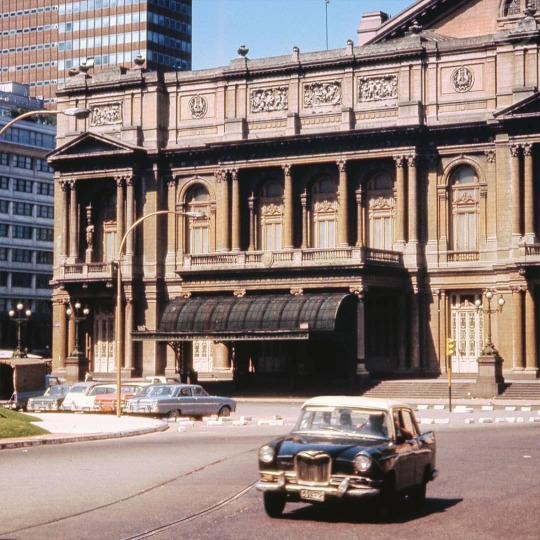
Another distant trip today though the OldMotors archives, this time to Buenos Aires. That’s el Teatro Colón in the background, Argentina’s most famous opera house. The taxi looks, at first glance like a big BMC Farina, but is in fact a Siam Di Tella 1500. A what? There’s no connection to Thailand. Siam started as an acronym for Sección Industrial Amasadoras Mecánicas (SIAM, the original name roughly translated to “mechanical mixer industrial concern”). As a part of Argentina’s Law of Foreign Investment reforms during the 1958-62 Presidency of Arturo Frondizi, the company inked a deal with BMC to build a locally-assembled version of the Riley 4/72, and that’s what became the Siam Di Tella 1500. Founded by Italian immigrant Torcuato di Tella in 1911 (three years after Teatro Colón opened), the company made industrial bread mixers and later grew enormous building oil pipeline components, but the 1930 coup meant turning to household goods. Di Tella’s real fortune came from refrigerators like Iso. Only much later did it branch into cars, just like Wolseley, which started as a sheep-shearing machine manufacturer. Torcuato, noted for being an economics prof, a patron of the arts, and a rabid anti-fascist, died in 1948, and his sons took over the company. Their first vehicle was the Siambretta, as you’d expect, a licensed version of the Lambretta scooter. With that experience, the firm was primed to make a car, and Frondizi’s industrial reforms made that happen. Argentina was at the time dependent on expensive car imports, and growing a domestic industry was of utmost importance in boosting standards of living. In late 1958 Siam arranged to build the Riley, powered by a low-compression BMC B-series four, with various modifications in Buenos Aires. There were also wagon and pickup (ute) versions of the SdT. There were also versions of the early Austin A60, briefly, and MG Magnette iterations of the Farina. Frondizi’s plan worked, and by 1966 Argentina was dominated by locally-assembled foreign cars, to Siam’s dismay as their economies of scale were limited. About 61,000 were made from 1959-66, when the company was taken over by IKA, who closed it in 1967. (at Teatro Colón) https://www.instagram.com/p/CMNubIkF1Tq/?igshid=bibspwcryope
0 notes